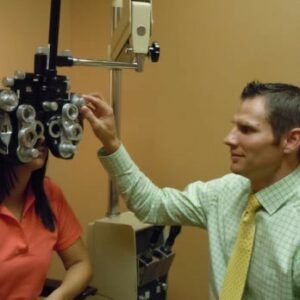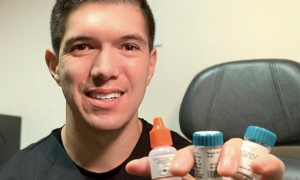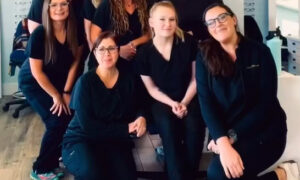
Dr. Hagberg with a patient. Dr. Hagberg says he and his team take the time to fully educate patients about all that they are prescribed. He notes that this makes a big difference to compliance, especially when there is an out-of-pocket expense for the patient.
Effectively communicating the value of your out-of-pocket products & services.
By Landon Hagberg, OD
April 3, 2024
Patients today want to see new technology when they go to the doctor—whether that doctor is an optometrist, dentist or general practitioner. If patients do not get a sense of technological innovation from our offices, they will often seek it elsewhere.
To make the most of the opportunity, however, we need to ensure that we are not only investing in the right technologies for our patient populations, but also presenting them thoughtfully. This is especially important because the procedures and products connected with these new technologies often require out-of-pocket payment.
Here is how I educate patients about the value of a new treatment or product, and why it’s worth investing in, even if their insurance does not cover it.
Explain the Treatment
For patients to agree to a treatment requiring out-of-pocket payment, they must understand the value: how and why it will help them.
For example, one of the technologies our practice adopted is the Neurolens Measurement Device, which provides a rapid, objective assessment of binocular vision, and facilitates precise prescription of contoured prism lenses to correct ocular misalignment. Patients are often surprised to learn that symptoms such as headaches, fatigue, neck and shoulder pain and motion sickness may be attributable to a problem with the alignment of their eyes.
Understandably, patients often look for solutions to these problems in separate places; they may ask their neurologist or primary care doctor about their migraines or their chiropractor about their neck pain. Indeed, at first, patients may be skeptical, wondering: “How can my eyes be the cause of my headaches and neck pain?” This provides me an opportunity to explain the technology in a way that patients can understand.
I may say, “Let’s compare this to a car. If you have poor alignment on your tires, your car is going to veer off in one direction. You can compensate and drive straight, but it is hard on your tires and bad for the car. The same goes for your eyes: the process of using your eyes when they are misaligned puts a lot of stress on your visual system and can result in other symptoms, like headaches and neck pain. So, if we can put your eyes in better alignment and reduce the extra stress, your other symptoms may be reduced, too.”
Using concrete, relatable examples can help patients understand enough about the mechanism at work to see the value in the technology and how it could benefit them.
Address What is Important to Patients
Patients may be more affected by the consequences of their conditions than the symptoms themselves, so helping patients understand the potential impact of a new therapy on their daily lives can further reinforce the value.
Other Articles to Explore
For example, research has shown that wearing Neurolenses can not only decrease symptoms, but also increase productivity.1,2
With their eye misalignment corrected, patients are often able to read and perform their jobs more effectively and with less pain—a result that could pay dividends in career advancement and satisfaction. In general, is important to help patients understand that the immediate financial outlay is not the only factor to consider when weighing the benefits and costs of a potential treatment.
Describe the Alternatives
Understanding the alternatives can also lend patients perspective.
For example, our clinic uses LipiFlow, a treatment for dry eye disease that is not covered by insurance, but is administered during a brief in-office procedure. Common alternatives include drops that must be administered multiple times daily, and although such options may be completely or partially covered by insurance, they must often be used chronically, throughout a patient’s life.
Thus, many patients see the value in paying more for a short, infrequent treatment versus smaller co-pays indefinitely.
Remove Barriers
For patients who may struggle to pay an out-of-pocket cost, we can make the treatment more affordable by offering financing via a health-specific credit card. Several platforms are available, and many incur no interest for a certain period of time.
Some companies, such as Neurolens, also guarantee their products, which may further reduce patients’ hesitation to try a treatment with out-of-pocket costs. Making new technologies more affordable, and reducing the risks for patients, can help to bolster their confidence.
Measure Success
Regardless of a patient’s willingness to try a new technology, it is important to measure the likelihood that they will be able or willing to pay for it. In our practice, we analyze weekly, monthly and yearly revenue to assess the success of the new therapies we adopted.
Since incorporating Neurolens and LipiFlow in the past couple of years, we have had an average increase in revenue of about $90 per exam.
Thoroughly understanding and explaining new treatments, addressing factors that are important to patients, describing alternatives, and removing barriers to therapy adoption, are key to maximizing the value of new technologies for your practice, as well as for the patients you serve.
References
1. Labhishetty, V. Neurolens: a comprehensive way to treat digital (computer) vision syndrome. Neurolens. Accessed January 4, 2023. https://5282963.fs1.hubspotusercontent-na1.net/hubfs/5282963/White%20Paper%20Booklet/Neurolens%20Symptom%20Relief%20White%20Paper.pdf
2. Labhishetty, V. Better binocularity, higher productivity. Neurolens. Accessed January 4, 2023. https://5282963.fs1.hubspotusercontent-na1.net/hubfs/5282963/Neurolens%20Productivity%20White%20Paper.pdf
 Landon Hagberg, OD, is an owner of Eye Associates of Nampa in Nampa, Idaho. To contact him: hagberg.6@gmail.com
Landon Hagberg, OD, is an owner of Eye Associates of Nampa in Nampa, Idaho. To contact him: hagberg.6@gmail.com



























